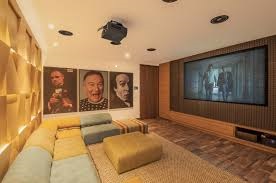Admin
November 3, 2024

In today's entertainment landscape, the role of acoustics is more critical than ever. Modern entertainment spaces—whether cinemas, auditoriums, music venues, or home theaters—rely on expertly crafted sound environments to deliver immersive, high-quality experiences that captivate audiences. Here’s an ultimate guide to designing acoustics for these environments, ensuring both functionality and aesthetic appeal.
Acoustic design for entertainment venues involves controlling sound quality, reducing noise interference, and optimizing audio clarity to enhance audience engagement. In large venues like cinemas and concert halls, acoustics must allow for clear sound projection without distortion or echo, even in the back rows. For smaller spaces, like home theaters and music lounges, design focuses on balance and eliminating reverberations that can detract from sound fidelity. This process involves planning room layouts, materials, and technology to create spaces that allow sound to travel naturally and evenly, immersing each listener in a consistent audio experience.
Effective acoustic design in entertainment spaces is guided by several principles:
Balancing these elements is essential to create an immersive experience, allowing each sound detail to reach listeners as intended.
Material selection plays a crucial role in acoustic performance. Advanced acoustic panels, baffles, and diffusers made from sustainable materials are becoming popular choices due to their environmental benefits and effectiveness. For example:
Using the right materials strategically ensures acoustic consistency across the space and enhances sound quality.
Each type of entertainment space has unique acoustic requirements. Here’s how to approach different environments:
Designing with the space’s function and audience size in mind creates a tailored sound experience that elevates the overall quality of entertainment.
Technology is revolutionizing acoustic design, allowing for greater control and customization. Advanced acoustic simulation software helps designers visualize sound behavior within a space, identifying potential issues before construction even begins. Additionally, digital signal processing (DSP) technology enables real-time audio adjustments, improving clarity and balance during live performances.
Incorporating these technologies ensures that entertainment spaces can adapt to varying performance needs and audience sizes without sacrificing sound quality.
Sustainability in acoustic design is becoming a priority as eco-conscious materials and energy-efficient systems gain prominence. Acoustic designers now have access to recyclable materials, biodegradable insulation, and energy-efficient sound equipment. Embracing green practices not only meets modern environmental standards but also appeals to an increasingly eco-aware audience.
Integrating sustainable elements into acoustic design not only benefits the environment but also enhances the space’s marketability and appeal.
The future of acoustic design for entertainment venues is focused on personalization and flexibility. Virtual and augmented reality advancements are allowing audiences to experience immersive soundscapes before a venue is even built. There’s also a growing emphasis on multi-functional spaces, where adaptable acoustic solutions allow venues to switch between uses seamlessly, such as converting a theater into a concert venue. Expect to see continued innovation in soundproofing technology and a stronger push for digital acoustics management, where acoustic properties are managed through digital interfaces for precise control.
Acoustic design is a defining element in modern entertainment spaces, shaping the way audiences experience sound. By understanding the unique requirements of each space, selecting appropriate materials, and leveraging advanced technology, Refined Acoustics ensures that every venue—from cinemas to music lounges—delivers a rich, immersive sound experience. As we look toward sustainable, technologically advanced acoustic solutions, the future of entertainment spaces promises to be as engaging as it is environmentally responsible.
© All Rights Reserved by Glim Global